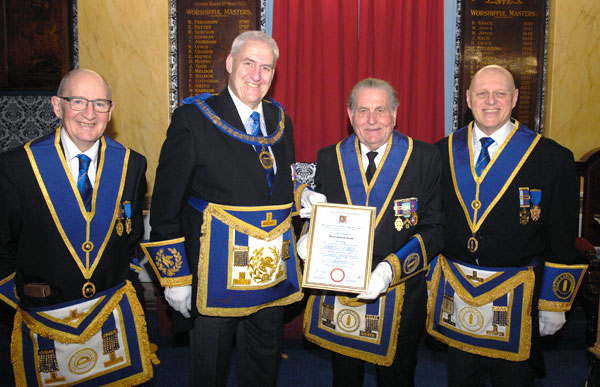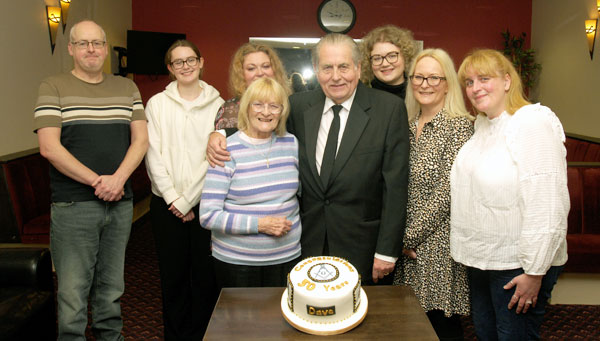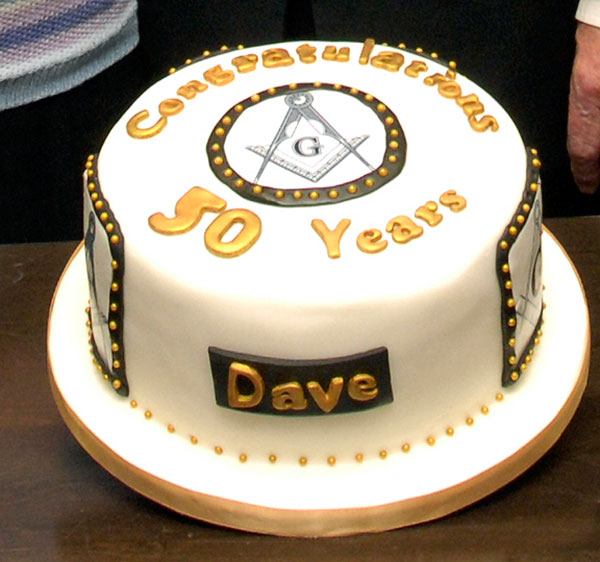Garston Masonic Hall was the venue for the celebration of David Jones’ 50 years in Freemasonry in Garston Lodger of Installed Masters No 9403. The lodge was opened in due form by the WM Hugh O’Neill who completed all the domestic business including a proposition for joining members from South Liverpool Lodge No 2681.

David Boyes, Assistant to the Provincial Grand Director of Ceremonies, announced Assistant Provincial Grand Master Andrew Whittle who demanded admission. The brethren were upstanding to receive Andrew, David Atkinson Mersey Valley Group Chairman and other distinguished brethren. The WM welcomed Andrew into the lodge and offered him the gavel which he accepted and asked the DC to place David Jones on a convenient seat before him. Andrew then gave some history of David’s life.
David was born in April 1944 in St Asaph Old Workhouse, North Wales, which had been converted to a Cottage Hospital during the Second World War. His father, Edward Ernest Jones, was both a farmer and coal miner, whilst his mother Megan was a Land Army Girl. After his birth David would be taken home to the 38-acre family farm in Gwespyr, a small mining and quarry village in Flintshire, North Wales. David was the first child born to his parents, but over the following years the family would grow with the birth of his younger brother Wallace who is currently 76, his older sister Carys who is 72 and finally his youngest brother Gwynfor who is 65 Incidentally, Gwynfor was born on David’s 15th birthday, so they have always been close. At the age of four David attended the local primary school which serviced the four local villages and was about one mile from each.
At the age of 11, David passed his “11 Plus” which in those days was just known as ‘The Scholarship’, this allowed David to attend the prestigious Holywell Grammar School. Whilst at Hollywell David found that he had a flair for rugby in the winter (but was never selected for the Welsh 15) and discus throwing during the summer athletics season. At the end of five years study, David obtained his General Certificate of Education in 1960. There was no such thing as grades in those days, you either passed or failed.
David did not enjoy secondary school as it was a long day, having to leave the house at 8:00am and not returning home until 5:00pm, and having to help on the farm for an hour both before and after the school day, then doing that dreaded homework for school next day. The only subjects David enjoyed at school were maths and technical drawing, both of which would to David’s delight be of use when he left school.
David discovered that the local colliery required an apprentice mining surveyor, following his application and the interview process, David was delighted to learn that he was successful. David was appointed by the Coal Board to the Point of Air Colliery, Flintshire and did his initial underground training at the ‘Dennis’ Seam’ in Gresford Colliery near Wrexham for three months. Safety was vitally important, and David said that nobody took it lightly given the location of their training.
David would also attend Wrexham College to obtain his Ordinary National Certificate and then Wigan Technical College to obtain his Higher National Certificate and his licence as a Mining Surveyor. Why the change of college and one so far from home? Well of course for the love of a lady and we will return to this a little later. David recalls that his apprenticeship was very comprehensive and included civil engineering and geology, which would prove to be an asset later in his career.
In 1963 David joined the Territorial Army and was stationed at the Royal Artillery in Prestatyn. His army career was only to last for three years until 1966, but he was able to pass several driving tests with the Territorial Army. David says that his licence gave him heavy goods under the age of 21, but only when in uniform on maneuverers.
The 372nd Flintshire and Denbighshire Yeomanry Field Regiment, with Royal Artillery, was a Welsh unit of Britain’s part-time Territorial Army (TA) formed after World War I from existing Royal Garrison Artillery and Yeomanry Cavalry units.
In World War II, it fought in the Battle of France and was evacuated from Dunkirk. It returned to North-West Europe in June 1944, participating in the battles in the Orne Valley and the bocage south of Caumont before the breakout from the Normandy beachhead, operations to close up to the Maas and the assault crossing of the Rhine (Operation Plunder). The regiment continued in the postwar TA, and a successor unit continues in today’s Army Reserve.
Sadly, the mining industry was in decline by the mid-60s due to the sudden decline in coal burning in both domestic, industry and transport. Coal mines were beginning to close and David saw the writing on the wall. Thankfully, Wigan Technical College produced a short course for newly qualified mining surveyors to enable them to qualify as either land surveyors or civil engineers. David thinking of the future, took the course successfully passed it.
In May 1968 David joined British Rail, his maternal grandfather one of the Birkenhead Welsh had been a train driver on the Great Western Railway and maybe the gene had surface in David, who knows! Of course, he was a civil engineering surveyor not a train driver, just at the time when they were electrifying the track from Crewe to Glasgow. On completion of this contract, David who thought he was on a four-year temporary contract, asked about the chance of a permanent job. His manager Peter Vine was surprised by the request and told David that he already had a permanent post and was in fact the most experienced man on the crew making him the governor. David then joined their Permanent Way Civil Engineers Office in Liverpool as Track Engineer until 1977.

David then took a three-year secondment in Bangor, North Wales as the Technical Liaison Engineer on the Britannia Bridge Road / Rail reconstruction project. A return to the homeland for a Welshman through and through. Although it did mean that he had to live in a caravan on the site for the duration of the project.
To complete a bridge of this span, supporting the weight of two railway tracks was a difficult prospect. Following the same conditions that had been put in place when Telford designed the Menai Suspension Bridge, Stephenson’s railway bridge also had to be high enough to allow ships to sail below it at all times. Stephenson came up with a revolutionary new tubular design that allowed a greater span without the need for suspension.
David would return to Liverpool after the secondment and resumed as a track engineer until 1985, when he was relocated to Manchester until 1989, and then relocated to Warrington until 1994 when British Rail was privatised. David remembers hiding some of the strategic spares in the final two years, as to raise funds British Rail would sell off any spares they could locate. David joined one of the new privatised companies Rail Track as a Contract Manager for North Wales and Merseyside. He said that once they were privatised it was if someone had turned on the money tap and it flowed faster than he had ever experienced. In 1997 David would then return to track engineering for the same area.
Turning to David’s family life; he met his wife Hazel whilst she was on holiday with her parents in 1963, near to where he lived in North Wales. Following that early encounter, they continued to see each other until 1966, when David came to work and live in Liverpool and they got married on the 13 August that year at Mossley Hill Church as Hazel liked the look of it for a wedding. So, the family’s long relationship with that Church commenced as they would become regular church attenders. In fact, Hazel is the current Church Warden, and her daughter is heavily involved in the brownies and other church activities.
David and Hazel have been blessed with three daughters, Carla who is 57 years of age and is married to Graham who is a member of St David’s Lodge No.2950, unfortunately he is not in attendance tonight as he is at Anfield watching the football match. Sharon who is 50 years of age and married to Harry, and Nerys who is 47 years of age today and is married to Roger. David has not had any real hobbies as he found his work to be so very interesting, that he regularly enjoyed visiting in his spare time other railway and civil engineering construction sites in the British Isles and Ireland. David also visited the construction of the Mass Transit Railways in South China, Hong Kong and Singapore, along with several railway Construction Sites in Europe and America.
David also has a passion for steam locomotives both rail and road, along with static and all other vintage vehicles and machinery, he would often attend shows and rallies whenever possible. He continues this passion to the present day but now at a much lesser pace. David, being a typical late 50’s early 60’s teenager, said that he enjoyed the music of that age being rock and roll, he was according to rumour a leather clad motorcycle fanatic with a BSA 175cc Bantam. His passion for motorcycles continued all his life he still has a 1957 James Captain 200cc, however he assures me that today he does not ride it anymore.
Once he passed his car test in the Territorial Army, David also acquired a motor car and he has had a car to the present day, during the 1970’s and 1980’s he loved towing the family mobile caravan throughout the British Isles, and this enable him to take Hazel and the children on many fantastic family holidays. Although David says he has now resorted to a static caravan in Penrith, North Lake District.
David’s favourite car was a white Volvo P1800 sports car, (Simon Templar ‘The Saint), which he enjoyed from 1969 to 1973, but that his second daughter’s arrival put paid to that and he then had to get a sensible family car.
The following are some of David’s greatest memories: Having a pint of beer with Tom Jones, the singer, in a pub in Chester in May 1965. Meeting Prince Charles in May 1980 at the opening of the Britannia Road Bridge in Bangor. Being with my wife when she met the Queen in Liverpool on Maundy Thursday 2000. Falling asleep on a train in West Germany and ended up in East Germany with no papers in 1985.
Let us know turn to David’s Masonic career. He was Initiated into Lodge of Harmony No.220 at Garston Masonic Hall on 27 February 1974. His proposer was George Donaghy and his seconder John Phillips, both of whom were railwaymen. David was passed to the degree of a fellow craft on 25 September 1974 and raised to the sublime degree of a master Mason on 18 May 1975. David did not stay in the lodge for long and resigned from the lodge on the 27 October 1976.
On the 30 April 1976, David became a joining member of St David’s Lodge. He rose through the progressive offices of the lodge and was installed as its master in 1986 for the first time. David also served the lodge as its master on a further three occasions being installed on 19 February2010, 21 February 2020 and 19 February 2021. David also held several of the important offices in the lodge over the years, serving long spells as secretary, almoner and director of ceremonies. In 2003, David produced the Centenary Booklet and was heavily involved in the arrangements for the lodge’s centenary celebrations, which were thoroughly enjoyed by everybody who attended the meeting.

David remembers with fondness a series of events that changed the future of St David’s Lodge. He was responsible for giving the Notice of Motion to close the Lodge of St David at the October 2019 meeting. Following a chance meeting at the Provincial Grand Mark Lodge meeting with Colin Boardman, former vice chairman of the Warrington Group of Craft Freemasons, St David’s Lodge was rescued by several brethren from the Warrington Group who turned it into a daytime lodge. David remembers well the first meeting at the lodge’s new home at Warrington Masonic Hall in October 2021, the lodge continues today going from strength to strength.
David became a founding member of Garston Lodge of Installed Masters No.9403 on 6 December 1991, and was installed as its master on 9 May 2007. David has been a real stalwart of the lodge since its formation having served as charity steward and as its secretary for the last 16 years.
David’s services to his lodge were recognised by the Province of West Lancashire on 16 October 2012, when he was promoted to the very high rank of Past Provincial Junior Grand Warden, the rank he still holds today. Garston Masonic Hall has been the home for David’s Craft and Royal Arch Freemasonry for 50 years and he is proud to meet at the hall, which over the years he has supported in many ways. In the late 1980’s he was responsible for providing the hall with a fire escape stairway from the upstairs of the building at the rear. More recently David managed a £10,000 legacy from the daughter of a Freemason to provide and install a disabled lift in Garston Masonic Hall for the benefit of its disabled and older members. We are absolutely delighted to see David here this evening to celebrate his 50th anniversary as a Freemason and even more so that he has allowed us to celebrate his special evening with him.
To read Andrew’s very interesting full script, with pictures, ![]()
David said that the various experiences during his 50 years of Masonic life have brought him considerable satisfaction, pride, and enormous pleasure. David hopes that he will have the opportunity to contribute to his lodge and chapter for many years to come. Such is the importance of a golden jubilee that our Provincial Grand Master Mark Matthews has caused a certificate to be struck to mark this wonderful achievement the contents of which were read by David Atkinson.
During the festive board, David was invited to the lounge were to his surprise his family were waiting for him to present him with a cake to celebrate 50 years in Craft Freemasonry. David’s youngest daughter Nerys together with two older sisters and friend Jan organised and produced it between them under the watchful eye of his wife, so it was truly a family cake.


